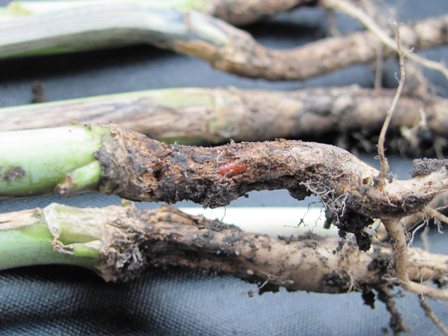Why Blackleg is becoming more Serious in Canola
With increasing acres of canola and often tighter rotations, blackleg disease has again started to become an important yield and quality reducing disease.
The development of blackleg resistant varieties has lead to reduced economic losses due to blackleg. As a result, many farmers are growing resistant varieties and they have been able to get away with tighter and tighter rotations. Preliminary observations from the 2010 canola disease survey show that in Manitoba the R-rated varieties are starting to show higher incidence and severity of the blackleg disease.
Why is there more disease?
Leptosphaeria maculans the pathogen responsible for causing canola blackleg has developed new variants and these new variants are now able to infect the earlier R-rated canola varieties.
When the blackleg resistant varieties were first developed, researchers categorized the pathogen into “PG” patho-groups, and was based on the infectivity of an isolate on 3 varieties - Westar, Glacier and Quinta. With changing blackleg populations, the PG classification is insufficient to describe newer variants. This means the PG system cannot identify variability among isolates as a result of sources of resistance not found in ‘Quinta’ and ‘Glacier’. Based on molecular markers, pathogen isolates have been able to be classified into PG groups, much quicker than the traditional plant inoculation method (Dusabenyagasani, M., and Fernando, W. G. D. 2008).
In a newer approach, by using varieties or lines of Brassica spp. carrying 14 specific resistance genes, new isolates of L. maculans can be differentiated or characterized into races based on the reactions observed. Rimmer (2007) had reported these 14 genes of specific resistance, designated Rlm 1 to Rlm 10 and LepR1 to LepR4. A study of 96 western Canadian isolates of blackleg fungus, using ten resistance genes indicated considerable variation in the pathogen population for many of these genes (Kutcher et al. 2010)
The canola industry in Canada and in other countries has mostly used specific genes for resistance. Specific resistance genes exert strong selection pressure on pathogen populations, which forces the pathogen populations to shift in virulence. This is simple terms explains the breakdown of resistance of some of the R-rated cultivars. Canola breeders have to come up with newer varieties tolerant to newer emerging pathogen variants, by using gene stacking of specific resistance or increasing horizontal resistance. Use of strategies such as variety selection or rotation of resistance genes over time, in combination with good quantitative resistance and best agronomic practices will be needed to manage blackleg in future.
Many fields in 2010 crop had a heavier than normal incidence of root maggot damage and this may have also contributed to many fields showing higher levels of blackleg disease. While not recommended, many canola growers are following a 1 year in 2 rotation. For these growers an additional fungicide application may become an important disease management tool in the future. To date, fungicide application for blackleg control has not been a norm for most Manitoba growers.

Blackleg infected canola roots and basal stems, also showing root maggot damage.
(Photo: Vikram Bisht)
References:
- 1. Dilantha Fernando W.G., Yu Chen and Kaveh Ghanbarnia. 2007. Breeding for Blackleg Resistance: The Biology and Epidemiology. Advances in Botanical Research 45:271-311.
- 2. Dusabenyagasani, M., and Fernando, W. G. D. 2008. Development of a SCAR marker to track canola resistance against blackleg caused by Leptosphaeria maculans pathogenicity group 3. Plant Dis. 92:903-908.
- 3. Kutcher H. R., Keri M., McLaren D. L. and Rimmer S. R.. 2007. Pathogenic variability of Leptosphaeria maculans in western Canada. Canadian J of Plant Pathology 29(4):388-393.
- 4. Kutcher, Randy and Yu, Fengqun. 2009. Blackleg revisited – races and resistance.
- 5. Rimmer, S.R. 2007. Chasing genes for resistance to blackleg and sclerotinia in Brassica napus. Proceedings 12th International Rapeseed Congress, Wuhan, China.
